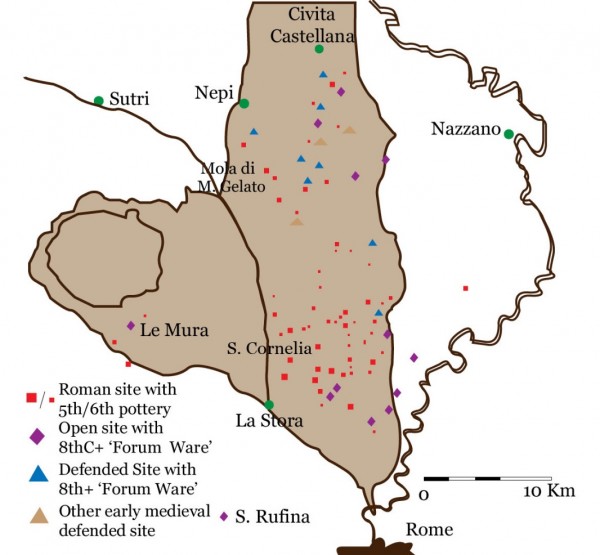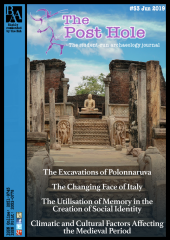Introduction
The Classical era of Rome has captured scholars’ imaginations for centuries, often to the extent that the Italian countryside is synonymous with the Roman villa. This output from classical studies has marred research in other time periods. Historically, the division between the settlement landscapes of late antiquity and the emergence of the villages in the 10th century, known as incastellamento, was seen as a time of darkness during which dispersed settlements continued with ‘squatter occupations’ (Hostetter and Howe 1997, 141). However, in recent times archaeological evidence has highlighted the slow transitions which occurred in the Italian landscape representing an evolution of settlement patterns which guided, and was guided by, political and social shifts. Ultimately, this allows us to discuss the specific issues which have emerged as evidence of the changing rural settlement landscapes.
From these recent archaeological debates, trends increasingly show that the changes in landscape settlement were slow transitions which left the landscape depopulated of its dispersed settlements and Roman villas which, with the shift towards village life, in turn created a pattern of nucleated settlements that fit into the wider political and social changes occurring at the time (Francovich and Hodges 2003, 13-21; Wickham 1999).
The Fate of the Villa
Large architectural complexes dominated the rural landscapes of the Roman west. As a result, they were the key focus of many archaeological excavations. However, later layers were often ignored; only in recent times have archaeologists begun tracking the transitions and transformations of Roman villas through excavations (Edwards 2012, 140). By beginning of the ninth century, the transformations of villas had assumed several forms; some had been replaced by monasteries or churches, while many others had been abandoned. By 700 CE, most had disappeared, monumentally changing the settlement landscape (Edwards 2012, 142-143). The reason for the disappearance of these villas, which had dominated rural settlement landscapes for centuries, has been a subject of continuous study. It was previously believed that these dispersed settlements continued with ‘squatter occupation’ until the process of incastellamento began in the 10th century. However, recent archaeological publications suggests a slow decline that began in the 3rd century and lasted until the 6th (Wickham 1999, 18).
Initially, the economic decline of the 3rd century affected all areas of Italy. In particular, it damaged the most structured villa systems that did not co-exist with small settlements. This was endemic with respect to the wider picture of economic depression due to Rome’s diminishing central authority (Alcock and Cherry 2012, 515). As time passed, villas underwent a slight revival with a re-distribution of space within the complexes. According to Ellis, this was part of a wider change in the use and management of land and involved using architecture, ceremony and decoration to maintain power and influence. Archaeological evidence of this can be seen at excavations of the House of Bacchus in Djemila along with the ‘Palace of Theodoric’ in Ravenna. The changes in layout prompted Lassus to suggest that these changes “imply a trend toward a more ceremonious architecture in domestic housing – they also support Olympiodorus's claim that public functions were being absorbed into private houses” (Lassus 1971, in Ellis 1988).
Finally, villas began to disappear completely during the 5th and 6th centuries (Francovich and Hodges 2003, 36). This was the last stage phase of decline and it is visibly evident in the archaeological record due to the final phase of a number of late villas. This final decline was due in particular to the provincialisation of Italy, which drew wealth to the provinces and alienated the upper classes. Subsistence farming had also become prominent. These changes led to the final marginalisation of the Roman villa (Francovich and Hodges 2003, 50; Lewit 2003).
Evidence for these facts comes in several forms, all supporting the slow abandonment of villas. For example, in many locations, the walls of Roman villas were used as supports for new, simpler roofing structures made of wood or straw (Marzano and Métraux 2017) and these instances of villa material re-use allows us to track the abandonment of villas and gain a better understanding of settlement changes.
Additionally, evidence showing how the rural settlement landscape changed can be seen at excavations of an abandoned 3rd-century villa at Frontanellato. Discovered above the 1.40m-deep layer of silt was a hut that had been built using some of the still-protruding villa walls as supports. The hut has a number of non-Roman type associations, such as hearths, small cemeteries and manufacturing activities (Marzano and Métraux 2017, 188). This prompted archaeologists to trace the relationship between ethnicity and rural settlements. By analysing associated contexts, archaeologists found evidence indicating the presence of Goth or Lombard populations and of 'Barbarian' settlements in Northern Italy. Archaeologists have interpreted these findings as representing a degree of continuity with the Roman economic network, of which villas and estates were essential components (Marzano and Métraux 2017, 188). This shows how material culture and architectural form can create an understanding of rural settlement changes in the past. In-turn allowing interpretations of the changes that took place as villas disappeared.
The Rise of the Village
With the disappearance of the villa in the 5th and 6th centuries, we see the beginnings of incastellamento, a process which saw the rise of the village and reshaped the Roman landscape from dispersed settlements characterised by the villa to clustered settlements which make up the familiar, Italian landscape of today (Francovich and Hodges 2003, 15). Previously, it was believed that the period between the 10th century and the demise of the Roman landscape in the 6th century was one of dispersed settlements, culturally referred to as the Dark Ages. However, archaeological excavations have shown that the 10th-century Italian hilltop villages originated in the 6th and 7th centuries (Ward-Perkins 2000, 324). In demonstrating the evidence for these hilltop villages, we can use the archaeological evidence to track how the rural settlement landscapes changed
Emerging during the 6th and 7th centuries, evidence can be seen in Tuscan hilltop villages which are discussed in the book Villa to Village (Francovich and Hodges 2003. Montarrenti is a hilltop village roughly 20km west of Siena. It controls a fertile valley that had sustained modest farms during the Roman period. Excavations showed that it was occupied from the mid-7th century (Francovich and Hodges 2003, 68), and that small rectangular huts were situated on the hilltop within a defensive palisade. Post-built structures were discovered in each of the three excavation areas, suggesting that the village contained many buildings.
This archaeological evidence is significant because it highlights three important factors. Firstly, by identifying the projections of regional authority and the territory that this village controlled, we can understand the relationships between this and previous settlements, highlighting the contrast between this spoke-like settlement with clustered dwellings and outreached agricultural land and the dotted, small, dispersed settlements which occupied the land before it. Secondly, the excavator’s conclusions regarding numerous buildings tell us about the large populations clustered together, highlighting the change in settlement landscapes (Francovich and Hodges 2003, 68). Finally, the presence of fortifications emphasises the larger historical narrative at play. The Lombard presence increased territorial fragmentations which can be seen in the projections of defence (Edwards 2012, 141).
This infers a socially unified desire to both manage and defend their respective territories as a collective (De Mola 2012). From this, it is my belief that we can see this change in settlement landscapes as an adaptive strategy to better manage food resources in an impoverished age. The empirical evidence of poor material culture seen at Montarrenti and other sites, such as Poggibonsi, show how distribution networks had collapsed (Francovich and Hodges 2003, 74). This may be due in part to the Gothic and Lombard wars (Edwards 2012, 141). However, more studies are required to create an accurate picture of the changing historical landscape which could highlight the reasons for this change.
Discussion of Changes
Throughout this essay - the word ‘characteristic’ has appeared several times. While the word itself is mundane, its repeated use hammers home the need to establish a starting point. As, in order to enable an accurate discussion about the change in rural settlement landscapes between late antiquity and the 9th century, what was ‘typical’ must first be established. This enables the use of a lineal approach to the discussions of the transitions and processes which led to our eventual conclusions of change which are surmised below.
The transition from a dispersed settlement landscape to a nucleated settlement pattern was previously believed to have taken place during the 10th century. However, archaeological evidence now shows a slow transition in which villas and dispersed settlements declined and villages began. The origins of this lie in the unstable 3rd century CE. During which – a combination of factors, such as economic decline and difficulties involved in maintaining an equilibrium between production activity and landscape exploitation along with feelings of insecurity due to the disastrous internal political situation, all compacted. Combined with several incursions by Barbarian forces – these shortly led to the decline of villas (Verreyke and Vermeulen 2009). After some short-lived economic upturns as elites attempted to maintain power, villas began to disappear completely during the 5th and 6th centuries (Francovich and Hodges 2003, 36). The rural population declined and hilltop villages became recognisable in the archaeological record. These nucleated settlements flourished during the 6th, 7th and 8th centuries, changing the rural settlement landscape to one of fewer settlements which are more condensed in population terms and primary focus on defence.
The discussion begins in late Antiquity around 300 CE, where the Roman rural settlement pattern was one of dispersed settlements (Figure 1). The main character of this dispersed pattern was the Roman villa. Towns were situated along roads and trade routes and acted as administrative centres and markets for the densely populated rural settlements (Edwards 2012, 142-143).

This typical rural landscape pattern can be seen in the archaeological evidence. Field walking within three sample areas in the upper Potenza Valley in central Italy showed 71 well-defined and non-problematic Roman “settlement sites” that had been identified by a combination of systematic survey results, field checks of crop and soil marks that aerial photography had revealed, and information from previous finds in the area. This provided information about the dense scatterings and dispersed nature of rural settlements in the landscape of late Antiquity.
In contrast, the 9th-century rural settlement landscapes had changed dramatically. The villa had all but disappeared and the nucleated lifestyles of hilltop villages had replaced dispersed settlement patterns. Archaeological evidence has allowed us to trace the beginnings of these hilltop villages. They were situated away from roads, and their overall concern about protection shows the historical changes that took place between these periods, when Rome’s stability had given way to new interpretations of territorialism. Evidence of this and of the early beginnings of the process known as incastellamento can be seen in the example excavation detailed above, in the section, the rise of the village (Figure 2). The defensive structures, which are seen in similar excavations (Francovich and Hodges 2003, 77-79), highlight how the new rural elites of the later eighth century and ninth century were in the process of re-organising local power and authority, in turn creating social divisions seen in a reinterpretation of territorialism.

These changes in the rural settlement landscapes were adaptive responses to changing conditions at the time. Evidence shows that the dissolution of Roman settlement landscapes occurred largely due to economic and political disasters that began in the third century. The beginnings of nucleated hilltop settlements are now seen as a peasant-led phenomenon which emerged from the absence of state control, the collapse of distribution networks and the virtual demise of the traditional rural aristocracy.
Conclusion
Throughout this brief paper, a discussion on the most instrumental - key changes in the Italian landscape between late Antiquity and the 9th century can be seen. A full discourse of the debate has been avoided – excluding the contrary arguments which other papers have mostly disproved. Instead, this paper has sought to focus on the most prominent underlying changes. The most relevant of these are the disappearance of villas and the rise of the village, which in many ways characterised the change seen in the rural landscape.
Rural settlement landscapes constituted a transitioning entity which shifted from a dispersed pattern of small, dispersed settlements – mainly villas – to nucleated settlements, situated primarily for defence (see Figures 1 and 2 for a comparison). These changes reflect the wider historical narrative at play, impacted by wars, economic decline and changing rural elites. In my summary of changes to the rural settlement landscape, I have sought to explain these changes using archaeological excavations and research to discuss the time periods involved, the reasons for these changes and the wider histories which affected them.






![A carved reindeer bone from a midden at Sumtangen (author’s own illustration). The runic inscription reads ‘ottar a’ (Óttár owns [this]). These name tags with a personal name and the verb ‘a’ are commonly found in middens in Norwegian towns (Indrelid and Hufthammer 2011, 45).](https://theposthole.org/sites/theposthole.org/files/styles/article_thumb/public/articles/_temp_thumbs/Owen%20Image%201.png?itok=sFxpxvar)

